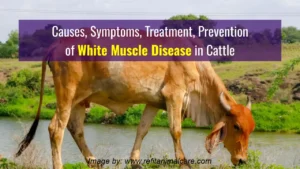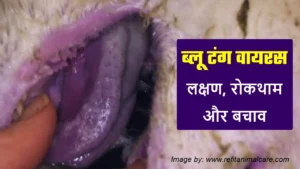During the recent change in the ecosystem, change of lifestyle, change in geography and farming patterns, the pets and cattle animals go through several unwanted diseases. These mostly take place due to lack of tracking cattle health, hormonal changes, unprepared diet during growth, etc. Grass Tetany is a disease, caused by an insufficient amount of magnesium in the cattle’s blood. Winter and spring are the high time to be prepared for Grass Tetany and be preventive for the same. People often confuse Grass tetany with milk fever, which are different symptoms, caused by magnesium and calcium deficiency in dairy cattle after the lactation period.

What is Grass Tetany in Dairy Cattle?
Dairy cattle suffer from grass tetany the most during its lactation period. For example, a cow requires an uninterrupted flow of magnesium due to the constant draining of the same by losing a huge amount of milk from the body. A dairy animal delivers an equal amount of magnesium in its milk even when there is a lack of magnesium fed. This is why they suffer symptoms of insufficient magnesium in the body, and Grass Tetany consequently. It is noted that a cow stays in a lactation period for a minimum of 6 to 8 weeks and it required a substitute magnesium source constantly during this period.

The Main Symptoms of Grass tetany :
- Muscle Stiffness
The cattle will suffer from stiffness in body muscles, mostly in legs and side muscles while being active, standing while lactation. The cow will fall suddenly by losing the strength of its legs. However, the symptoms are different from milk fever which results in to weak muscles.
- Irritable Beheviour
Cattle, reared from birth, are expected to be stable and familiar with the owner. However, grass tetany can cause increased irritability in cattle behavior. An irritable cow may show reduced interest in eating and may not be as friendly with the owner of the shed. A visible series of such symptoms may indicate grass tetany in the cattle.
- Gazing Away from the herd:
A cow running away from the herd is a major risky symptom. It indicates a questionable situation the cattle is going through. Mostly the cattle of 3 or 4 years old, suffer from such symptoms of Grass Tetany. This can even lead the cattle to death or coma.
- Death and coma:
Cattle, mostly dairy cattle are found dead or in a coma due to Grass Tetany. The cows found dead without any prevalent disease are victims of this disease.
Apart from these, lack of magnesium reflects in the cattle food quality, beef quality of the cattle reared in the same pattern, etc.
Contributing causes are:
- The levels of magnesium decrease in grasses during summer. Whereas weeds and legumes carry a good quantity of the same.
- The use of nitrogen fertilizers and potash bring a huge change in the food and leave insufficient magnesium in the fields as well as the crops and grasses.
- Less than sufficient amount of energy consumption, fasting during the lactation period or hormonal changes periods, unpleasant weather, panicking ambiance, winter storms, etc are responsible for bad cattle health or trauma that lead to a rapid difference in the health of cattle.
- Not feeding phosphorus enriched food to castles, using them as transports, or carriage for heavyweight goods cause the direct or indirect impact of having grass tetany or lack of magnesium in cattle health.
Can Grass Tetany be Treated after the damage?
Yes, Grass Tetany can be treated medically by restoring the magnesium level in the dairy cattle blood. It is wiser to conduct the metho by veterinary administration. The intravenous solution for restoring calcium and magnesium is the most popular medically approved process to save cattle from grass tetany.
However, in the severe stages of the disease, the cattle might require to inject calcium and magnesium solutions into the skin or provide an external oral solution of magnesium through the food. You can also inject these into the cattle by yourself, the products are widely available in your nearest veterinarian store.
What are the Prevention and control of Grass Tetany?
Prevention is always better than cure. So in case, you are reading the blog for awareness of your battle heath, you should keep the following in mind.
- Cut off the actors from your farm, that reduce the magnesium.
- Include a magnesium supplement in the regular diet of the cattle, especially in their lactation period.
- Provide salt as a natural substitute for magnesium and calcium if the medical solution is not available.
- Keep the cows, buffalos in a shelter in case of emergency and eliminate the stressful activities.
- Providing energizing food with good quality of the grass is suitable for a healthy attle.
- Make sure that the grass fields are enriched with phosphate fertilizer.
- As a long-term action, plant trees in rows, for shelter.
- Keep a track of the cattle for the future prevention of disease.
- Create the perfect soil by balancing and correcting the soil acidity with lime or dolomite.
- A lactating cow should be provided 2 grams of magnesium for each 2 kg. Of dry food.
What is a Grass Tetany in Sheep?
Grass tetany is a symptomatic animal disease, that appears from a lack of magnesium in the animal blood. The lactating cattle, cows buffalo, sheep, etc are the victims f this disease. Yet, Sheep are more sensitive to such disorders in comparison to cows. The metabolic rate differentiation of the sheep from cows has made them more open to such deficiency. When the potassium and nitrogen intakes are high but phosphorus intakes are low, and the sheep are involved in herds with lower mineral components, they suffer from this disease. Sheeps suffering from this, require immediate treatment after confirmation of the magnesium deficiency. From a medical perspective, an external source of magnesium should be provided to the cattle, along with keeping track of the heart rate. The subject is expected to be cured within 16 hours of the initial treatment.











